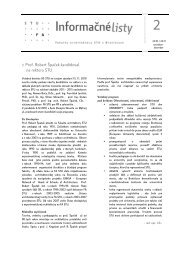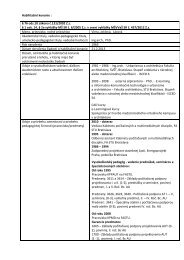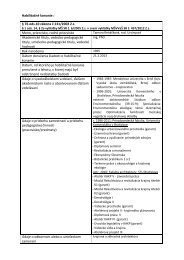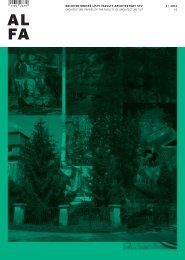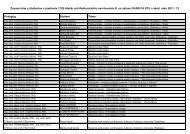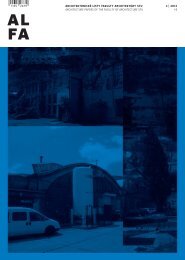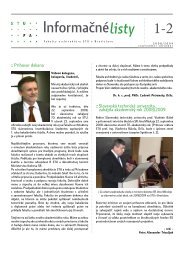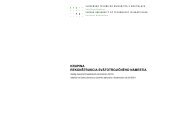ALFA 3-4/2005 - Fakulta architektúry STU
ALFA 3-4/2005 - Fakulta architektúry STU
ALFA 3-4/2005 - Fakulta architektúry STU
You also want an ePaper? Increase the reach of your titles
YUMPU automatically turns print PDFs into web optimized ePapers that Google loves.
Ročník 9<br />
3-4 / <strong>2005</strong> ARCHITEKTONICKÉ LISTY FA <strong>STU</strong><br />
This paper presents the relations between terms<br />
in Foucault’s philosophy and terms in computer graphics.<br />
The attention is particularly focused on curves in Foucault’s<br />
description of relations in diagram and on NURBS splines<br />
in animation software.<br />
The main goal of this paper is to show why NURBS<br />
geometries have become so important for architects, who are<br />
using animation concepts in their works.<br />
Introduction<br />
As a thesis researcher of the subject Animated Forms I was<br />
invited by Imro Vaško to become one of the advisors of a summer<br />
term project at the Laboratory of Architecture at the Academy of<br />
Art. The students were supposed to explore fluid spaces and blobkind<br />
structures. I, as a researcher of animated forms, felt quite<br />
comfortable in accepting that challenge. It turned out to be slightly<br />
more challenging, than I was expecting.<br />
At that time, there were few questions/subjects, that mostly drove<br />
my/our interest: the importance of topology, fluid forms, usage of<br />
non-Euclidean spaces, animated techniques in architecture and<br />
NURBS surfaces. Although I had already been studying that<br />
subject for two years, discussions with other students revealed<br />
many more questions, and some of them have kept me busy until<br />
now. One in particular has been very persistent and has opened<br />
up many new views in this area of research for me. It was Juraj<br />
Sukop, who asked me that question. He as a former student of<br />
mathematics and a good programmer was from the beginning<br />
trying to discredit the potential of animated techniques and input<br />
of such architects as Gregg Lynn. He asked, why is it so important<br />
for Gregg Lynn to work with NURBS surfaces or why it just<br />
couldn’t be the surface of a mathematic function. I have to admit,<br />
that at that time I wasn’t really able to answer the question, but as<br />
I already said I kept it in mind while researching my thesis and I<br />
believe that now I can do so.<br />
At that time my understanding of NURBS was as the best a way<br />
to construct smooth curved surfaces in a computer. Greg Lynn has<br />
been using it with Maya ® and he has been also writing about it, so<br />
I believed him, and even more,<br />
I somehow became to think about it as the only possibility how to<br />
draw smooth surfaces. I have realized that I have almost<br />
completely ignored the possibility of drawing a surface as a result<br />
of a given function and that I was also not sure what are<br />
the differences between them. I saw the advantage of NURBS in<br />
its parametric attribute. I felt that the algorithmic character makes<br />
it more suitable for an animated form or that the time value in its<br />
algorithm somehow guarantees fluidity and animated attributes of<br />
1 See page 54<br />
Ján ŤUPEK<br />
NURBS IN ANIMATED ARCHITECTURE<br />
- 52 -<br />
resulting form. Later I believed that its advantage was mainly in<br />
the ability to visualize smooth shapes and also to<br />
reinterpret/recode the geometry to production machines.<br />
At that time I used to think of NURBS as a more non-Euclideanlike<br />
geometry and on the other hand about Á a polygonal geometry as<br />
a Cartesian-like geometry. Nurbs as a topological U and V vector<br />
based geometry and polygon as a X,Y,Z point based geometry.<br />
The surface or spline as a result of a mathematical function was<br />
something, that has been overlooked in this dualistic perspective.<br />
Neither the algorithmic quality nor the ability of creating perfect<br />
smooth geometry persuades me of the importance and<br />
inevitability of Gregg Lynn’s work.<br />
Fortunately, after further reading Lynn’s, Foucault’s and Deleuze’s<br />
books, I found out why NURBS and works of these people are so<br />
connected and why the use of this geometry was the best choice<br />
for Lynn.<br />
Animation and NURBS<br />
At first thought the term “animated forms” would probably evoke<br />
the idea of animated films and films as such. Greg Lynn, a pioneer<br />
of animated technique in architecture, implies this connection as<br />
well. Educated as an architect and philosopher as well, he uses in<br />
his projects animating software, which were primarily developed<br />
for special effects within the film industry. Even some of his<br />
concepts are inspired by Hollywood bestsellers (for example<br />
Predator, The Blob, etc.) These methods can at first sight look less<br />
serious and shallow. They can be understood just as an effort to<br />
find an uncommon and complicated form.<br />
A deeper investigation regarding the uses of animated methods in<br />
architecture, by architects as Greg Lynn and Lars Spuybroek,<br />
reveals direct connections to the works of Frei Otto or Antony<br />
Gaudi. On the other hand detailed reading of their writings refers<br />
to philosophical works of G.Deleuze, M.Foucault and ancient<br />
Greece.<br />
If it is possible to summarize the most important aim of these<br />
methods, then I would use the word “complexity”. Complexity, by<br />
means of dragging away from idealized bipolarized meanings. All<br />
this in order to be able to work at once with as wide a range of<br />
differentiated and integrated variables as possible. Presence or<br />
simultaneity is an important condition and at the same time one of<br />
the reasons for the use of animated softwares and parametrical<br />
geometries.<br />
One of the methods how they are trying to reach the complexity is<br />
a work within a space between fixed or specified forms/ terms. It<br />
is not anymore a game between two opposites like fullness and<br />
emptiness or point and space. The attention is brought to



